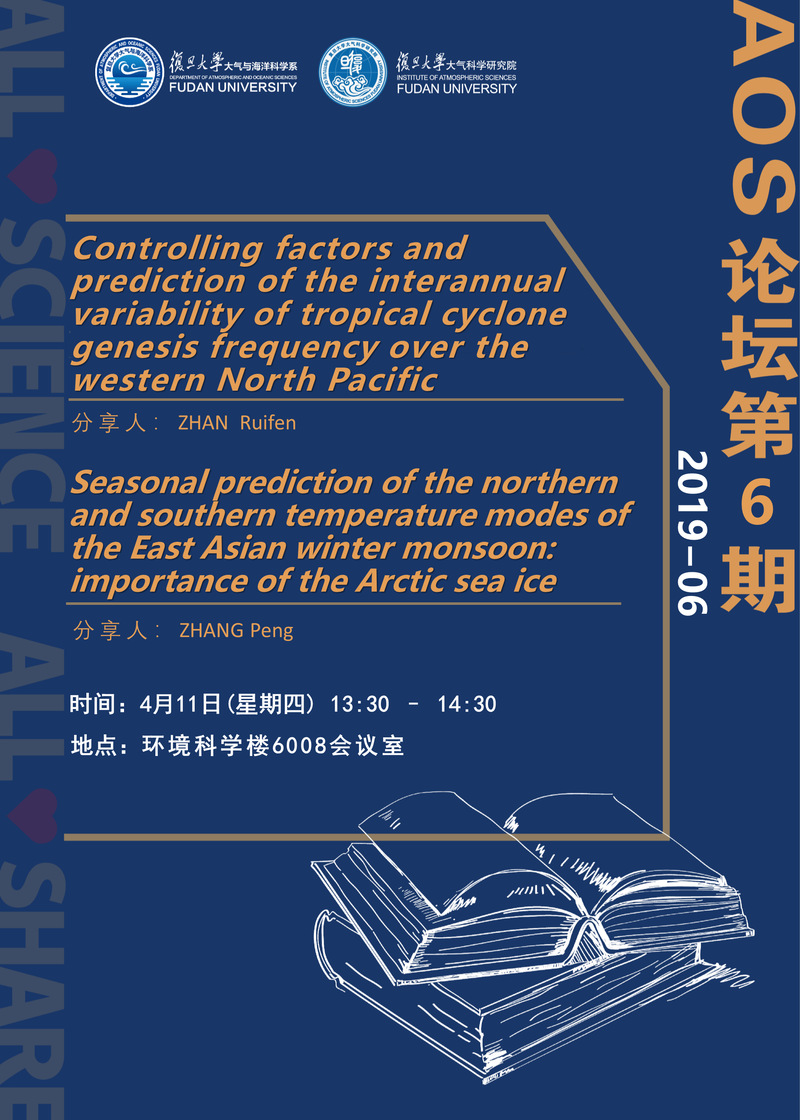|
|
|

Title: Controlling factors and prediction of the interannual variability of tropical cyclone genesis frequency over the western North Pacific ZHAN Ruifen Abstract: Tropical cyclone (TC) activity on interannual time scale is largely controlled by the slowly-evolving large-scale atmospheric circulation patterns and the oceanic thermodynamic conditions. This study attempts to evaluate quantitatively the contributions of sea surface temperature (SST) anomalies in the Indo-Pacific Oceans to the interannual variability of TC genesis frequency (TCGF) over the western North Pacific (WNP). Three SST factors in the Indo-Pacific Oceans are found to play key roles in modulating the interannual variability of WNP TCGF. They are summer SST anomaly in the East Indian Ocean (EIO), summer El Niño-Southern Oscillation Modoki index (EMI), and spring SST gradient (SSTG) between the southwestern Pacific and the western Pacific warm pool. Results show that the three factors together can explain 72% of the total variance of WNP TCGF in the typhoon season for the period 1980-2015. Among them, the spring SSTG and the summer EIO contribute predominantly to the interannual variability of TCGF, followed by the summer EMI, with their respective contributions by 39%, 38% and 23%. Further analysis shows that the summer EMI was affected significantly by the spring SSTG and thus had a relatively lower contribution to the TCGF than the spring SSTG. In addition, a statistical model and a statistical-dynamic model are constructed to predict the WNP TCGF in the typhoon season. Especially, the new statistical model can reproduce well the observed WNP TCGF and shows an overall better skill than the ECMWF seasonal forecasting system 5 (SEAS5) hindcasts.
Title: Seasonal prediction of the northern and southern temperature modes of the East Asian winter monsoon: importance of the Arctic sea ice
ZHANG Peng Abstract: Previous research work found that the East Asian winter monsoon (EAWM) is dominated by two distinct surface air temperature (Ts) modes—the northern (N-) and the southern (S-) modes. The inter-annual variations of these two modes were attributed to preceding Eurasian snow cover anomalies and El Nino–Southern Oscillation (ENSO). Observed evidence in this study shows that sea ice anomalies on Barents-Kara (BK) and Laptev seas and those on Chukchi-Beaufort (CB) Sea in autumn have co-mingled effects on the abnormal EAWM. If negative sea ice anomalies appear in the BK and northern CB Sea in September, the following winter Ts anomaly over East Asia is represented by a significant cooling north of 40°N, which highly resembles the EAWM N-mode. If negative sea ice anomalies occur in BK-Laptev Sea and positive sea ice anomalies in the southern CB Sea, the winter Ts anomaly over East Asia exhibits a significant cooling over the south of 40°N and corresponds to the EAWM S-mode. The above results indicate that autumn Arctic sea ice can provide another predictability source for the EAWM, besides ENSO and Eurasian snow cover. To further verify its contribution to seasonal prediction of the EAWM, a series of physical-empirical models are established using the combinations of September Arctic sea ice, autumn Siberian snow cover and ENSO. Hindcast experiment output shows when adding autumn Arctic sea ice into the predictors, the cross-validated prediction skill is significantly improved. |
|
|